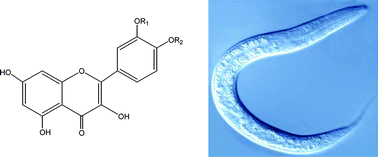Effects of O-methylated metabolites of quercetin on oxidative stress, thermotolerance, lifespan and bioavailability on Caenorhabditis elegans†
Abstract

* Corresponding authors
a
Grupo de Investigación en Polifenoles, Unidad de Nutrición y Bromatología, Facultad de Farmacia, Universidad de Salamanca, Campus Miguel de Unamuno, Salamanca, Spain
E-mail:
csb@usal.es
Fax: +00 34 923294515
Tel: +00 34 923294537
b Center for Biomedical Research of La Rioja (CIBIR), Logroño, Spain

 Please wait while we load your content...
Something went wrong. Try again?
Please wait while we load your content...
Something went wrong. Try again?
F. Surco-Laos, J. Cabello, E. Gómez-Orte, S. González-Manzano, A. M. González-Paramás, C. Santos-Buelga and M. Dueñas, Food Funct., 2011, 2, 445 DOI: 10.1039/C1FO10049A
To request permission to reproduce material from this article, please go to the Copyright Clearance Center request page.
If you are an author contributing to an RSC publication, you do not need to request permission provided correct acknowledgement is given.
If you are the author of this article, you do not need to request permission to reproduce figures and diagrams provided correct acknowledgement is given. If you want to reproduce the whole article in a third-party publication (excluding your thesis/dissertation for which permission is not required) please go to the Copyright Clearance Center request page.
Read more about how to correctly acknowledge RSC content.
 Fetching data from CrossRef.
Fetching data from CrossRef.
This may take some time to load.
Loading related content
